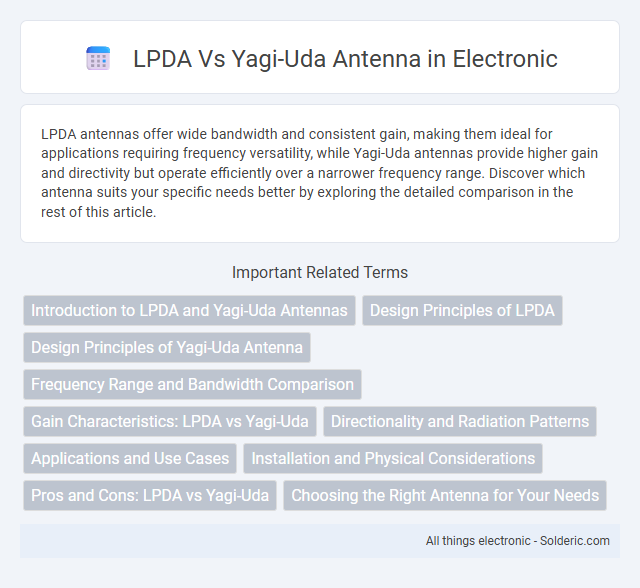LPDA antennas offer wide bandwidth and consistent gain, making them ideal for applications requiring frequency versatility, while Yagi-Uda antennas provide higher gain and directivity but operate efficiently over a narrower frequency range. Discover which antenna suits your specific needs better by exploring the detailed comparison in the rest of this article.
Comparison Table
| Feature | LPDA Antenna | Yagi-Uda Antenna |
|---|---|---|
| Type | Log-Periodic Dipole Array | Directional Wire Antenna |
| Frequency Range | Wideband, typically 2:1 or more | Narrowband, optimized for specific frequency |
| Gain | Moderate, 6-9 dBi | High, up to 12 dBi or more |
| Directivity | Moderate | High |
| Impedance | Approximately 50 Ohms, stable over frequency | Varies with frequency, usually matched at design frequency |
| Bandwidth | Wide (multi-octave) | Narrow (single frequency band) |
| Physical Size | Longer relative to the lowest operating wavelength | Shorter for the same gain at a specific frequency |
| Applications | Broadband communications, scanning, HF and VHF bands | TV reception, fixed-frequency communications, radar |
| Complexity | More complex design and construction | Simple and easier to build |
Introduction to LPDA and Yagi-Uda Antennas
LPDA (Log-Periodic Dipole Array) and Yagi-Uda antennas are widely used for directional signal reception and transmission, each optimized for specific frequency ranges and bandwidths. The LPDA antenna offers broad bandwidth and consistent performance across multiple frequencies, making it ideal for applications requiring versatility. In contrast, the Yagi-Uda antenna provides high gain and directivity at a narrower frequency range, benefiting users focused on targeted signal enhancement.
Design Principles of LPDA
The Log-Periodic Dipole Array (LPDA) antenna employs a series of dipole elements with gradually varying lengths and spacing, creating a frequency-independent design that offers wide bandwidth performance. Each element is scaled by a constant factor, ensuring that at any given frequency, a subset of elements is actively resonant, enhancing impedance matching and radiation efficiency. This structural approach contrasts with the Yagi-Uda antenna's fixed element lengths and spacings, which are optimized for narrowband gain and directivity.
Design Principles of Yagi-Uda Antenna
The Yagi-Uda antenna consists of a driven element, typically a half-wave dipole, accompanied by multiple parasitic elements including one reflector and several directors arranged in a linear array to achieve directional gain. Its operation relies on the constructive interference of radio waves scattered by these elements, which enhances signal strength in the desired direction while minimizing radiation elsewhere. Precise spacing and length tuning of reflector and director elements relative to the driven element are crucial for optimizing forward gain and front-to-back ratio.
Frequency Range and Bandwidth Comparison
LPDA antennas provide a significantly wider frequency range and superior bandwidth compared to Yagi-Uda antennas, making them ideal for applications requiring multi-band or broadband performance. Yagi-Uda antennas excel in narrowband scenarios, offering higher gain and directivity within a limited frequency span typically suitable for single-frequency or narrowband communication. Your choice between the two depends on whether broad frequency coverage or focused gain at specific frequencies is more critical for your needs.
Gain Characteristics: LPDA vs Yagi-Uda
LPDA antennas provide consistent gain over a wide frequency range, making them ideal for broadband applications where signal strength remains stable across multiple bands. Yagi-Uda antennas typically offer higher peak gain but over a narrower frequency band, optimizing performance for targeted frequencies. Your choice depends on whether you prioritize broad frequency coverage or maximum gain at specific frequencies.
Directionality and Radiation Patterns
LPDA antennas provide broad directional coverage with a smooth, well-defined radiation pattern across a wide frequency range, making them ideal for applications requiring consistent performance over multiple bands. Yagi-Uda antennas offer highly focused directionality and a narrow radiation pattern, resulting in stronger signal gain and improved reception from specific directions. You can choose LPDA for versatile, wideband use or Yagi-Uda for targeted, high-gain communication.
Applications and Use Cases
LPDA antennas excel in broadband communication applications such as television signal reception, spectrum monitoring, and electronic warfare due to their wide frequency range and consistent gain. Yagi-Uda antennas are preferred for point-to-point communications, amateur radio, and direction finding, offering high gain and directivity within a narrower frequency band. You should choose LPDA for versatile multi-frequency tasks, while Yagi-Uda suits specialized high-gain, single-frequency applications.
Installation and Physical Considerations
LPDA antennas require precise spacing and alignment of multiple dipole elements along a boom, demanding careful calibration during installation to achieve optimal broadband performance. Yagi-Uda antennas feature fewer elements closely spaced on a single boom, allowing for simpler mounting and typically lighter overall weight, which facilitates easier installation on various structures. Both antennas necessitate sturdy support and appropriate environmental protection, but LPDA's extended element spread demands more clearance and careful positioning to avoid signal distortion.
Pros and Cons: LPDA vs Yagi-Uda
LPDA antennas offer wide bandwidth and stable gain, making them ideal for applications requiring frequency agility, while Yagi-Uda antennas provide higher gain and directivity for focused signal reception in narrow frequency ranges. LPDA's complex design and larger size can be less efficient for single-frequency use, whereas Yagi-Uda's simpler structure is cost-effective and easier to build but suffers from limited bandwidth. Your choice depends on whether you prioritize frequency range versatility or maximum gain and directivity for specific frequencies.
Choosing the Right Antenna for Your Needs
LPDA antennas offer wide bandwidth and stable gain, making them ideal for applications requiring frequency versatility such as broadband communication and signal monitoring. Yagi-Uda antennas deliver higher gain and directivity within narrow frequency bands, optimal for long-distance point-to-point communication and targeted signal reception. Selecting between LPDA and Yagi-Uda depends on the frequency range, gain requirements, and the specific application environment to ensure optimal performance.
LPDA vs Yagi-Uda antenna Infographic

 solderic.com
solderic.com